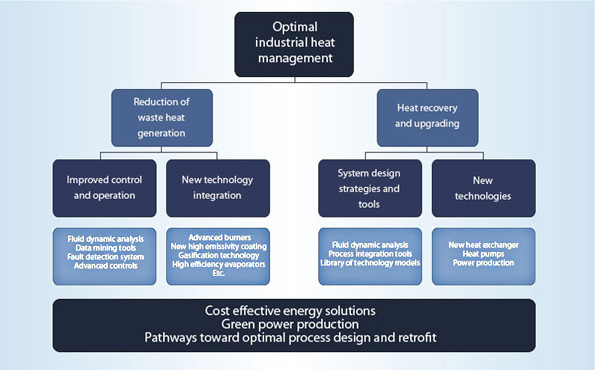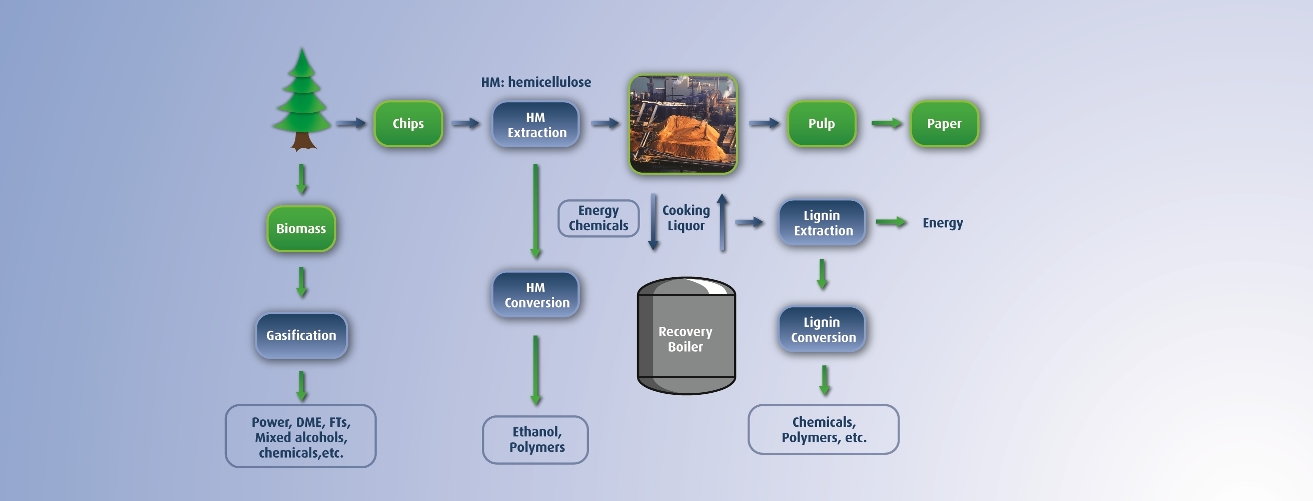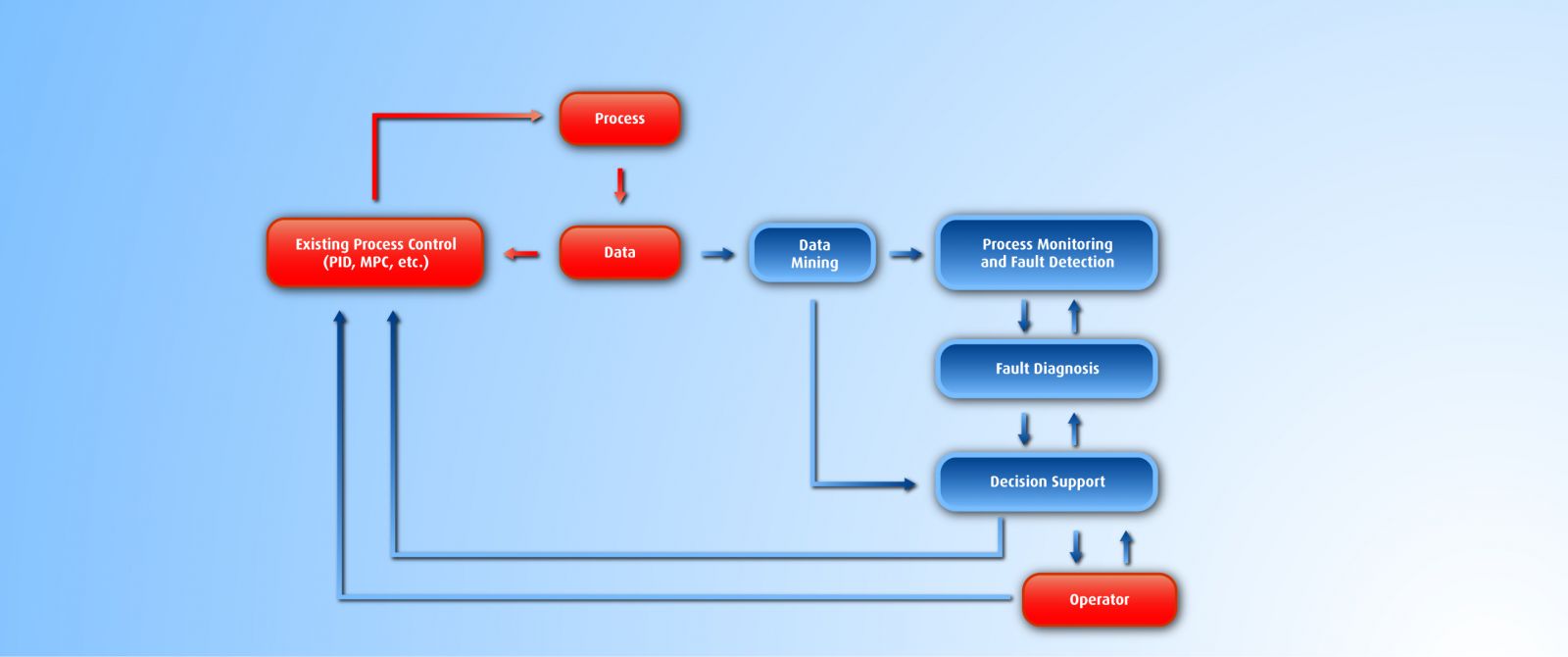CanmetENERGY’s industrial process optimization research and development efforts are focused on developing methods and tools to help improve the overall efficiency of industrial facilities by enhancing existing methods and implementing new design and retrofit approaches.
These efforts can therefore be aimed at improving the energy performance of existing equipment or at optimizing an industrial facility’s overall energy and water use all while reducing greenhouse gas emissions.
In Canada, certain industrial sectors consume large quantities of water and energy. This is particularly true for the pulp and paper and oil sands industries, which together account for approximately 20% of Canadian industrial energy use.
The main ongoing and early-stage research and development activities address the following areas:
- Waste heat recovery and upgrading
- Forest biorefinery
- Efficient process operation through fault diagnosis
These activities, which primarily target energy-intensive sectors and industrial processes, are aimed at developing innovative and transversal approaches adaptable to multiple industrial sectors.
Waste heat recovery and upgrading
Every year, significant amounts of energy produced by industrial processes are wasted in the form of liquid or gas flows. From an industrial point of view, energy recovery from waste heat is a priority and provides the best opportunity for reducing energy consumption.
Identifying sources of waste heat in a given facility is relatively easy. However, determining the most appropriate applications and technologies for recovering such heat requires a great deal of perseverance and creativity. The possible applications are numerous and wide-ranging as they vary from one industrial sector to the other, and even from one location to the next within a given industrial process.
Decision-support tool
This project’s main objective is to develop a decision-support tool for use in determining the best solutions for waste heat recovery and upgrading, while taking into account the following:
- A plant’s overall context (i.e. determining how any given waste heat flow can best be used considering the plant’s other energy flows)
- Impacts on energy generation services in order to assess real savings rather than apparent savings observed in a given plant sector
- Possible improvements to existing energy generation services, including refrigeration, steam generation and distribution, and power generation systems
Database, classification and methodology
The project will also result in:
- An electronic database containing detailed information on a wide range of waste heat recovery and upgrading technologies, including performance models
- The classification of waste heat sources and identification of typical projects providing energy savings in various industrial facilities
- The development of a methodology for better knowledge-based decision making and of energy generation service models
Text Version
Text version of images - Waste heat pathways
Waste heat pathways
Optimal industrial heat management translates into:
- Reduction of waste heat generation
- Heat recovery and upgrading
Reduction of waste heat generation includes:
- Improved control and operation
- New technology integration
- Fluid dynamic analysis, data mining tools, fault detection systems, and advanced controls
- Advanced burners, new high emissivity coating, gasification technology; high efficiency evaporation, etc.
Heat recovery and upgrading includes:
- System design strategies and tools
- New technologies
- Fluid dynamic analysis, process integration tools and library of technology models
- New heat exchanger, heat pumps and power production
All these technologies and tools provide:
- Cost effective energy solutions
- Green power production
- Pathways toward optimal process design and retrofit
Forest biorefinery
This project’s main objective is to develop a systematic integration methodology for assessing the effects of implementing biorefinery technologies in pulp and paper mills in regards to:
- The plants’ energy profile and water consumption
- Air emissions
- The plants’ economic outlook
Three biorefinery technologies available for implementation and integration in Kraft pulp manufacturing plants will be investigated:
- Lignin extraction and processing
- Hemicellulose extraction and processing
- Biomass gasification
Text Version
Integrated Forest Biorefinery
This diagram represents three biorefinery technologies susceptible to being integrated into pulp and paper plants. There is a picture of a tree in the upper left corner of the diagram, from which there is a series of arrows pointing toward the bottom and another series of arrows pointing toward the right. These arrows are linked by various textboxes representing different stages and options of technology integration.
The first downward arrow leads to a green textbox with the word “Biomass”, and then continues on to a blue textbox representing the “Gasification” stage. From there, a final arrow points to a colourless textbox that reads “Power, DME, FTs, mixed alcohols, chemicals, etc.”
Returning in the upper left corner, the arrow pointing to the right of the tree leads to a green textbox containing the word “Chips”, and then to a blue textbox with the term “Hemicellulose Extraction”. From there, the series of arrows continues on to the right but there is also a second series of arrows pointing toward the bottom.
The first downward arrow points toward a blue textbox with the term “Hemicellulose Conversion”, and then to another colourless textbox with the words “Ethanol, Polymers”. Back at the top, the right-pointing set of arrows from the “Hemicellulose Extraction” textbox continues on to a picture of a pulp and paper plant, then to a green textbox containing the word “Pulp”, and finally to the final green textbox of that series containing the word “Paper”.
However, below the image of the plant, there is also an arrow pointing downward to a cylindrical shape representing a recovery boiler. There is a second arrow leaving from the recovery boiler and pointing upward to the image of the plant. Between these two arrows, the words “Cooking Liquor” can be read. On the other side of the downward arrow, to the left of “Cooking Liquor”, there is a colourless textbox with the words “Energy, Chemicals”.
From the upward arrow, there is another arrow pointing right to a blue textbox containing the term “Lignin Extraction”. From this textbox, another arrow pointing right leads to the word “Energy” while a second arrow below the textbox points downward to a blue textbox containing the term “Lignin Conversion”. A final arrow leaves from this textbox and points to a colourless textbox below containing the words: “Chemicals, Polymers, etc.”
Integrated Forest Biorefinery
The project team is developing a unified energy optimization methodology that will take into account the complex interactions between the various energy systems found in a modern facility in terms of its energy generation, steam and water usage, and heat recovery sequences. This methodology will be used to develop strategies for implementing biorefinery units in Kraft plants, based on actual case studies.
The ultimate goal consists in offering innovative, practical and economically viable technological biorefinery solutions for transforming plants’ operational models by allowing them to manufacture a wide range of innovative value-added bio-products, in addition to their main activities.
Decision-support tool
The knowledge acquired through the application of design methods in this sector will be integrated into a decision-support tool and used to ensure efficient integration of the biorefinery. In terms of modernizing plants in retrofit mode, the tool will:
- Provide engineering rules for a forest biorefinery and instructions for its implementation in a Kraft plant
- Calculate the energy and water use profiles of an integrated biorefinery
- Assess the CO2 emission levels associated with the integrated biorefinery
- Provide product platforms and the family of products derived from the integration of a biorefinery in a Kraft plant
The decision-support tool is intended for plant engineering teams as well as engineering consulting firms working with the pulp and paper industry.
Partnerships
Activities related to this project are conducted jointly with several partners, including FPInnovations, the École Polytechnique de Montréal and Hydro-Québec. The project also benefits from FPInnovations’ Biorefinery Initiative, which allows many pulp and paper plants to offer and share data required for analyses. The project is consolidated through a direct collaboration with the École Polytechnique de Montréal’s NSERC Chair in Environmental Design Engineering.
Efficient process operation through fault diagnosis
Maintaining a competitive edge in the manufacturing sector requires process performance monitoring and abnormal situation management. Despite the increasingly common use of advanced control systems (e.g. model predictive control tools), some sectors, notably the pulp and paper industry, continue to face abnormal situation management issues. This challenge is due to the fact that the few existing commercial tools are primarily intended for expert users and therefore do not help control room operators in understanding the abnormal situations or in diagnosing anomalies in order to restore the normal functioning of a process.
Automatic fault detection and diagnosis system
CanmetENERGY experts are working toward developing and implementing an automatic fault and detection diagnosis system that will:
- Perform an online analysis of operating data
- Provide users with useful and structured information
- Allow decision making
This system will use a (qualitative and quantitative) hybrid method and will systematically integrate innovative software tools to allow operators to better understand the process and its control conditions, so as to improve the overall plant functioning and management of abnormal situations. By identifying possible malfunctions early on in the process, operators will be able to take immediate corrective action, thereby ensuring that the process is operating within normal limits, and also to improve the equipment maintenance plan, which will in turn reduce energy consumption and increase productivity.
The system will consist of generic and modular computerized toolboxes that will be easily reusable, at low cost, in several other industrial applications. It will also be capable of automatic learning, so as to continuously feed new information into the database in order to improve system capacity. The system will include the following toolboxes:
- A knowledge base module with qualitative and quantitative data modelling
- An inference engine, including malfunction detection and classification agents
- A diagnostic procedure using various agents to identify malfunctions
- A user interface with the required communication capacities
A method to determine how the various toolboxes may be used either individually or together will also be developed, allowing new applications for different processes to be easily built.
Text Version
Process detection & diagnosis system
The following image represents a process detection and diagnosis system overseeing an existing control system. The various steps are connected by arrows indicating the order of operations and the links between them.
On the left, there is a diagram of an existing control system with its three elements (the Existing Process Control, the Process, and the Data) all linked by arrows. From the Data element, an arrow points to a process detection and diagnosis system represented on the right. The first component of this system is that of Data Mining; secondly, there is the Process Monitoring and Fault Detection step, followed by the Fault Diagnosis stage of the operation; and finally, there is the Decision Support step. Following this last step, improvements are either automatically implemented in the process or made by a system operator who physically administers the suggested changes.
Process detection & diagnosis system (in blue) to supervise existing control system (in red).
Contact us
CanmetENERGY is seeking partners interested in collaborating on these research projects. To discuss a potential partnership, please contact us.


